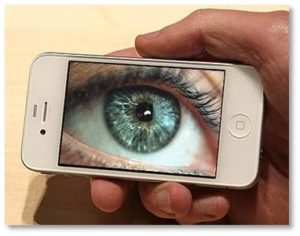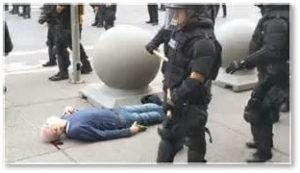My plan to write another post about Boston for today got disrupted by the very disturbing video clips of police violence against protesters and marchers. Back in 2016, I wrote a post about how the ubiquitous presence of smartphones, with their cameras and video cameras, were changing society—and would do more. The current protests drove this home.
 Four years ago, I said that: “…when everyone had a smartphone—in whatever model from whatever company—and could distribute what they recorded to the entire world instantly, it created a tipping point.”
Four years ago, I said that: “…when everyone had a smartphone—in whatever model from whatever company—and could distribute what they recorded to the entire world instantly, it created a tipping point.”
Thanks to smartphones, the world has reached another long-overdue tipping point.
When I was a kid, I remember my parents telling us that, if we ever needed help or had a problem, we should look for a police officer. It came as a shock to realize, much later in life, that this did not apply to black children. Their parents tell them to avoid the police—and with good reason.
The Awful Footage
Unless you live on Mars, you have seen the awful footage of Officer Derek Chauvin murdering George Floyd by kneeling on his neck for almost nine minutes. By doing so, the former policeman ended one man’s life, destroyed his own, pulled three other police officers down with him, and kicked off riots and protests across the United States and the entire world.
But that was just the beginning.
In the past week, we have seen more violence perpetrated by police officers against peaceful protesters, journalists, bystanders, and even people who have asked them for help. The images are graphic and disturbing, some so outrageous as to be unbelievable. To white people, that is. I doubt if any black people have been surprised by what they have seen and experienced.
Some Video Footage of Police Violence
 In case you only watch TV news and don’t do social media, I offer a partial list of what has appeared on my computer.
In case you only watch TV news and don’t do social media, I offer a partial list of what has appeared on my computer.
- A 75-year-old white man in Buffalo, New York, who appears to try and talk with a police officer, gets pushed to the sidewalk. He hits his head and begins to bleed on the sidewalk. The police walk past him as though he is just an object.
- A young woman sitting on the street with her hands over her face is kicked over by a police officer while other uniformed officers stand around and watch.
- In Los Angeles, the police shot a homeless man in a wheelchair in the eye with rubber bullets. He was not part of any protest or march. Just, you know, there.
- The police shove an old guy with a cane to sidewalk with their shields. In this case, they appear embarrassed and help him back up again.
- In Indianapolis the police brutally beat a female protester with their batons.
- You can watch these and more on this video made by Kumail Nanjani.
- Or you can scan over 300 clips compiled by a North Carolina lawyer. (Go to T. Greg Doucette on Twitter)
We have seen lines of helmeted men wearing face guards and wielding arm shields pushing protesters. I have seen officers swing their batons like baseball bats, hitting arms, legs, rib cages, any body part they could find. We watched NYC police cars drive right through a line of protesters. Others opened the doors of moving squad cars to sideswipe demonstrators.
Putting the Lie to Excuses
Pre-smartphone, the only footage we would have see would have been taken by journalists and the presence of their big cameras often changed the action. Footage of the 75-year-old man in Buffalo was taken by an NPR affiliate. But, before smartphones, Mr. Floyd’s death would have been invisible.
The whole uproar would never have happened because the police would have explained his murder as justified because he was resisting arrest. Seeing the bystander’s video coverage not only put the lie to that excuse, it forced us to watch the inhuman behavior of a police officer who watched a man die under his knee.
We Begin to Understand
Now we privileged white people begin to understand the violence that has been perpetrated against black people for generations—and how the police have lied to justify their actions. We begin to understand because we are being forced to confront it.
 As Kumail Nanjiani pointed out on Twitter, the cops in Niagara Square said that the old man they pushed instead “tripped and fell.” The videotape showed otherwise and the two officers responsible have been suspended. All 57 members of the city’s Emergency Response Team resigned in protest–not of the assault but of the suspension.
As Kumail Nanjiani pointed out on Twitter, the cops in Niagara Square said that the old man they pushed instead “tripped and fell.” The videotape showed otherwise and the two officers responsible have been suspended. All 57 members of the city’s Emergency Response Team resigned in protest–not of the assault but of the suspension.
We look at a long, long list of black men and women who have been assaulted and killed on the streets and in their own homes by officers exerting unnecessary force that’s all out of proportion to the presumed offense, and sometimes completely by mistake.
The use of counterfeit currency in Georgia, the crime George Floyd was apprehended for, is a felony that carries a potential sentence of 20 years in prison—not a death sentence. At trial, the prosecutor must prove that the defendant acted with criminal intent to defraud. George Floyd got no trial, no defense attorney, and no chance to plead his innocence.
Question Authority — Again
The graphic video of his death has led millions of people to question authority, as we did back in the sixties. People who have complacently accepted the official excuses and the lies can no longer do so.
 I would like to believe that not every cop is violent, that it’s just a few bad apples. I really would. Like most white people, Because I am a white woman, I never had to fear the police. I respect the police and the difficult job they do. Yet it’s difficult to watch these videos, to see the evidence with my own eyes, and believe that it’s just a few. How many is “just a few?”
I would like to believe that not every cop is violent, that it’s just a few bad apples. I really would. Like most white people, Because I am a white woman, I never had to fear the police. I respect the police and the difficult job they do. Yet it’s difficult to watch these videos, to see the evidence with my own eyes, and believe that it’s just a few. How many is “just a few?”
And when does “aggressive policing” turn into police brutality? How do you measure it? Where do you draw the line?
Drawing the Line on Police Brutality
I would like to believe that most police are like the officers who took a knee or marched and prayed with protesters. Are there more of them than of the helmeted, shielded, baton-wielding para-military police we see on the TV news?
Does it count when a police officer warns armed members of The Proud Boys and other white supremacists to take cover before they use tear gas on the crowd of protesters. He said he was warning them “discreetly” so protesters wouldn’t see the police “play favorites.” Think about who the police are favoring here.
And then we see the enablers: The officers who roust the bystanders filming the attack. The officers who block the view so no one can really see what’s happening. The police who attack journalists covering the protest march. What about the three men who sat on a man who had not even been arrested and who watched as he died. Are they good apples who got caught up in the moment or bad apples just looking for an excuse to beat a black person up? How do we know?
The Quandary We Struggle With
 This is the quandary America is struggling with right here and right now. We haven’t found any easy answers.
This is the quandary America is struggling with right here and right now. We haven’t found any easy answers.
Cities have begun the process by suspending, arresting, and charging some of the offenders. The next step takes changing the mindset that says every black man is guilty of something, every black woman can be treated like dirt. The police must change the mindset that says, “I can do this without fear of reprisal.” That’s a lot more difficult.
Does our understanding come too little, too late? You bet it does. Did it take too much to get white people to even start to grasp the problem? Undoubtedly. We clung so hard to lies, prejudice, stereotypes, and justifications that it took the undeniable evidence provided by smartphone videos to convince us. We believe what we see with our own eyes.
It pains me to write this post because it says so clearly that we are not better than this — and we never have been. All we can do is work on it. Let’s do that.
